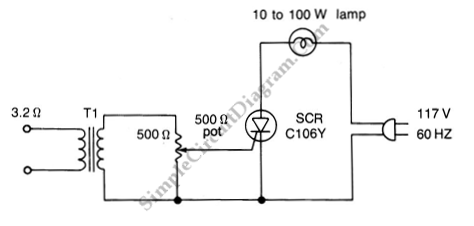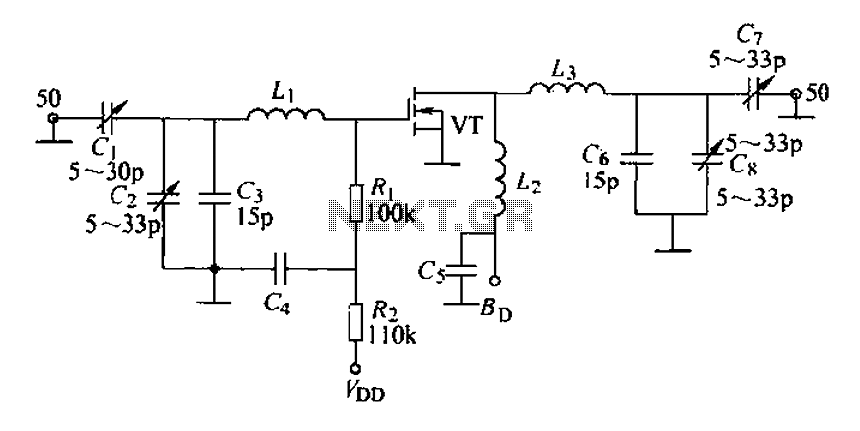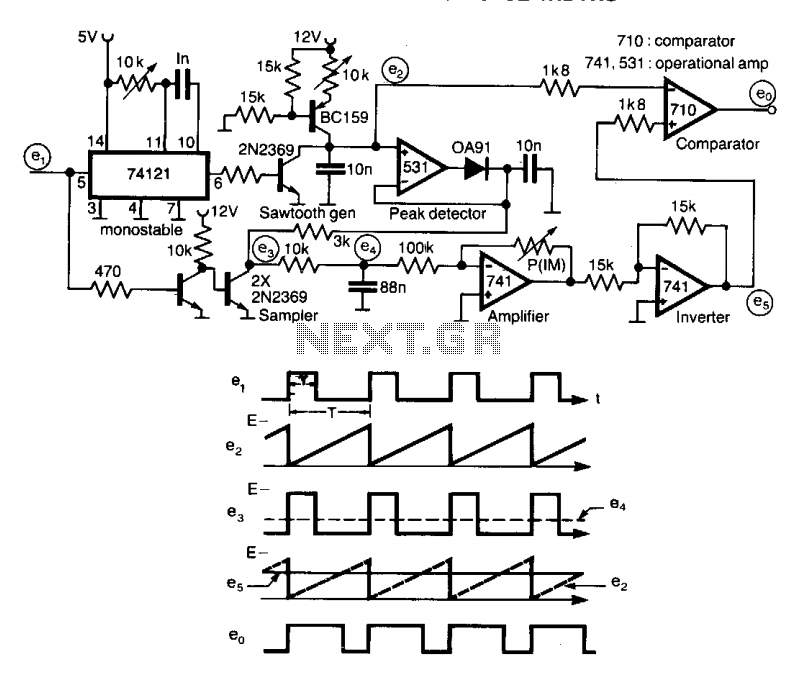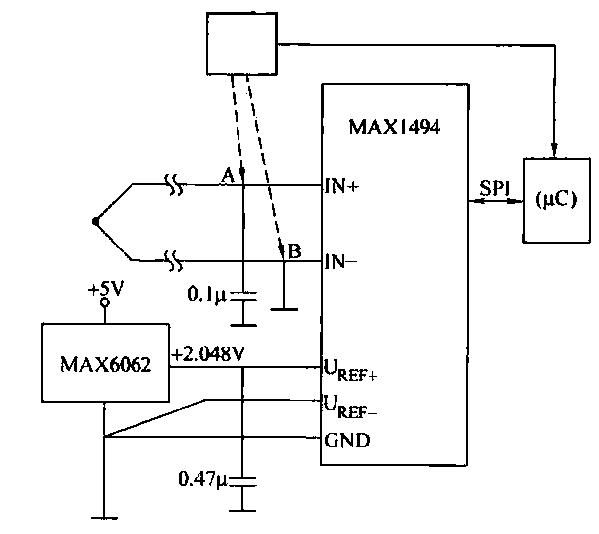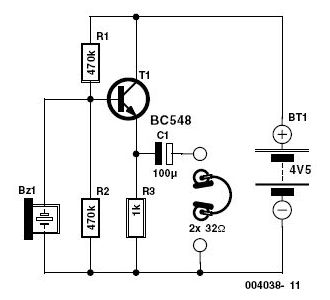
Valve oscillator circuit 100 Metres and Below
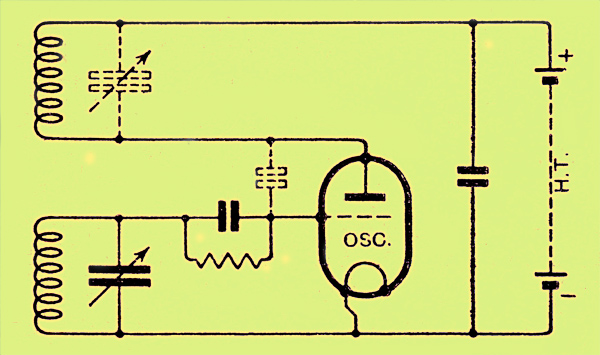
The congestion of the ether is increasing, prompting ongoing efforts to extend communication channels to higher frequencies. Wavelengths as short as 12 meters are now common, but operating below this presents significant challenges. At approximately one meter, the oscillation period aligns with the time it takes for electrons to travel between the valve's electrodes, leading to the breakdown of conventional valve-oscillator theory. The accompanying article traces the history of short-wave communication and summarizes the current state. The fundamental oscillator circuit relies on resonance between grid and anode circuits, where the electrostatic coupling from the valve's electrode capacitance is sufficient to induce oscillation. Since World War I (1914-1918), increasing congestion in radio communication has led to attempts to expand the range of available frequencies. By the war's end, commonly used wavelengths ranged from 100 to 20,000 meters (3 kHz to 15 kHz). The 10-15 kHz range is close to the audio frequency spectrum, limiting further extension, necessitating the exploration of wavelengths below 100 meters (above 3,000 kHz). The development of wavelengths below 100 meters, down to 15 meters, has become well-known. One significant advantage of using ultra-short waves is the efficiency of aerial systems, allowing stations to be placed closer together due to frequency differences. However, the waveband between 15 and 100 meters quickly became congested, prompting investigations into even shorter waves. As predicted by theory, it was soon found that these very short waves could not be reflected or refracted by the ionosphere, eliminating the phenomenon of skip distance associated with direct and indirect rays. Additionally, ground waves experienced rapid attenuation, resulting in limited range for equipment positioned near the ground. The effective range was directly related to the antenna's height. However, if two stations were in direct line of sight, long ranges could be achieved with minimal power, exhibiting behavior akin to shorter light waves, thus being termed quasi-optical. Early in the exploration of these waves for communication, it was suggested that altering the antenna's effective height could control the transmitter's service area, and directive aerial systems proved to be both efficient and cost-effective. Despite theoretical predictions and initial results, some researchers believed that long ranges could be achieved with these waves. Recent experiments have supported this notion, with ranges exceeding optical limits recorded, such as between France and Corsica on wavelengths around 3 meters, and more recently, a distance of 168 miles between ship and shore on a wavelength of 57 centimeters, as presented by Marchese Marconi at a Royal Institution lecture. The propagation mechanisms in these instances remain unclear. Prior to these developments, methods for generating very short waves had been used sporadically, mainly for physical research. Most successful methods are based on the triode in various forms. There are two circuit designs suitable for this purpose.
The exploration of high-frequency communication has led to the design of various electronic circuits that facilitate the generation and transmission of short and ultra-short waves. Fundamental to these circuits is the oscillator, which can be configured using triodes or other vacuum tubes. The oscillator circuit typically consists of a tank circuit, which includes an inductor and capacitor that resonate at the desired frequency. The resonance condition is critical, as it ensures that the energy supplied by the oscillator is efficiently transferred to the antenna system.
In a typical triode oscillator circuit, the triode acts as an amplifier and oscillator. The grid and anode circuits must be tuned to resonate at the same frequency, allowing for the electrostatic coupling to sustain oscillation. The use of feedback, often through a capacitive or inductive coupling, ensures that the output signal maintains the necessary amplitude for effective transmission.
For ultra-short waves, the design of antennas becomes crucial. Antennas must be carefully designed to match the wavelength being transmitted. As the wavelength decreases, the physical size of the antenna also decreases, necessitating the use of specialized designs such as loop antennas or Yagi-Uda arrays, which can provide the required directivity and gain.
The propagation characteristics of very short waves require consideration of environmental factors such as terrain and atmospheric conditions. While these waves do not reflect off the ionosphere, they can achieve line-of-sight communication over significant distances when the transmitting and receiving antennas are elevated. This characteristic allows for the implementation of systems that can effectively utilize these frequencies for point-to-point communication.
In summary, the advancements in short-wave communication and the exploration of ultra-short waves have led to innovative circuit designs that leverage the unique properties of high-frequency signals. The oscillator circuits, antenna designs, and propagation considerations form a comprehensive framework for modern communication systems operating in these challenging frequency ranges.The congestion of the ether is becoming so great that efforts are continually being made to extend the channels of communication to higher frequencies. Wavelengths as low as 12 metres are now commonplace, but attempts to work below this are fraught with many difficulties.
At about one metre the period of oscillation is comparable with the time tha t the electrons take to pass from electrode to electrode in the valve, and the ordinary valve-oscillator theory breaks down. The accompanying article outlines the history of short-wave communication and summarises the position today.
The fundamental oscillator circuit. If grid and anode circuits are in resonance the electrostatic coupling produced by the valve`s electrode capacity is sufficient to cause oscillation. Since the War (1914-18), on account of the increasing congestion in the field of radio communication, attempts have been made to extend in every possible direction the range of frequencies available for this purpose.
At the close of the War the generally used wavelengths ranged between 100 and 20, 000 metres (3, 000 to 15kHz), Since the 10-15 kHz range verges upon the audio frequency spectrum, there was obviously no room there for extension, so wavelengths had perforce to be found in the zone below 100 metres (above 3, 000 kHz). How the use of wavelengths below 100 metres and down to 15 metres was developed is now a matter of fairly common knowledge.
Of course, there was one great advantage in the possibility of using ultra-short waves, apart from the relatively efficient aerial systems which could be used in connection with them, ie, the fact that stations could be packed closer (since the spacing was a matter of frequency difference) as the wavelength was reduced. Even so, the waveband between 15 and 100 metres soon became congested, and so the possibility of using even shorter waves was soon investigated.
Though it is not really within the province of this article, it may be profitable to discuss briefly the properties of these very short waves. As predicted by theory, it was very soon discovered that they were too short to be reflected or refracted by the ionosphere, and therefore there was no phenomenon of skip distance, due to the presence of the direct and indirect rays.
Also the ground wave suffered very rapid attenuation, so that sending or receiving apparatus situated close to the ground had a very short range. In fact, the range bore a direct relationship to the height of the antenna from the ground. If, however, the two stations were situated so as to be within sight of each other, very long ranges were obtained with very small powers.
The waves behaved in this way in a very similar manner to the much shorter light waves, themselves the name quasi-opt1cal. Very early during the pioneer work on these waves in the field of communication it was suggested that it would be possible to control the service area of a transmitter by altering the effective height of the antenna.
The use of directive aerial systems was also easy and economical. But some workers in this particular branch of radio communication have long felt that, in spite of theory and early results, it might be possible to attain long ranges with these waves. Some recent experiments have tended to confirm this view, ranges well beyond the optical range having been attained, first between France and Corsica on wavelengths of the order of 3 metres, and lately between ship and shore over a distance of 168 miles on a wavelength of 57 centimetres announced at a recent talk before the Royal Institution given by Marchese Marconi.
The mechanism of propagation in these cases is not yet understood. Prior to this time, methods of generating very short waves had been sporadically used, mostly for physical research purposes. The basis of nearly all successful methods is, of course, the triode, in one form or another. There are two forms of circuit suitab 🔗 External reference
The exploration of high-frequency communication has led to the design of various electronic circuits that facilitate the generation and transmission of short and ultra-short waves. Fundamental to these circuits is the oscillator, which can be configured using triodes or other vacuum tubes. The oscillator circuit typically consists of a tank circuit, which includes an inductor and capacitor that resonate at the desired frequency. The resonance condition is critical, as it ensures that the energy supplied by the oscillator is efficiently transferred to the antenna system.
In a typical triode oscillator circuit, the triode acts as an amplifier and oscillator. The grid and anode circuits must be tuned to resonate at the same frequency, allowing for the electrostatic coupling to sustain oscillation. The use of feedback, often through a capacitive or inductive coupling, ensures that the output signal maintains the necessary amplitude for effective transmission.
For ultra-short waves, the design of antennas becomes crucial. Antennas must be carefully designed to match the wavelength being transmitted. As the wavelength decreases, the physical size of the antenna also decreases, necessitating the use of specialized designs such as loop antennas or Yagi-Uda arrays, which can provide the required directivity and gain.
The propagation characteristics of very short waves require consideration of environmental factors such as terrain and atmospheric conditions. While these waves do not reflect off the ionosphere, they can achieve line-of-sight communication over significant distances when the transmitting and receiving antennas are elevated. This characteristic allows for the implementation of systems that can effectively utilize these frequencies for point-to-point communication.
In summary, the advancements in short-wave communication and the exploration of ultra-short waves have led to innovative circuit designs that leverage the unique properties of high-frequency signals. The oscillator circuits, antenna designs, and propagation considerations form a comprehensive framework for modern communication systems operating in these challenging frequency ranges.The congestion of the ether is becoming so great that efforts are continually being made to extend the channels of communication to higher frequencies. Wavelengths as low as 12 metres are now commonplace, but attempts to work below this are fraught with many difficulties.
At about one metre the period of oscillation is comparable with the time tha t the electrons take to pass from electrode to electrode in the valve, and the ordinary valve-oscillator theory breaks down. The accompanying article outlines the history of short-wave communication and summarises the position today.
The fundamental oscillator circuit. If grid and anode circuits are in resonance the electrostatic coupling produced by the valve`s electrode capacity is sufficient to cause oscillation. Since the War (1914-18), on account of the increasing congestion in the field of radio communication, attempts have been made to extend in every possible direction the range of frequencies available for this purpose.
At the close of the War the generally used wavelengths ranged between 100 and 20, 000 metres (3, 000 to 15kHz), Since the 10-15 kHz range verges upon the audio frequency spectrum, there was obviously no room there for extension, so wavelengths had perforce to be found in the zone below 100 metres (above 3, 000 kHz). How the use of wavelengths below 100 metres and down to 15 metres was developed is now a matter of fairly common knowledge.
Of course, there was one great advantage in the possibility of using ultra-short waves, apart from the relatively efficient aerial systems which could be used in connection with them, ie, the fact that stations could be packed closer (since the spacing was a matter of frequency difference) as the wavelength was reduced. Even so, the waveband between 15 and 100 metres soon became congested, and so the possibility of using even shorter waves was soon investigated.
Though it is not really within the province of this article, it may be profitable to discuss briefly the properties of these very short waves. As predicted by theory, it was very soon discovered that they were too short to be reflected or refracted by the ionosphere, and therefore there was no phenomenon of skip distance, due to the presence of the direct and indirect rays.
Also the ground wave suffered very rapid attenuation, so that sending or receiving apparatus situated close to the ground had a very short range. In fact, the range bore a direct relationship to the height of the antenna from the ground. If, however, the two stations were situated so as to be within sight of each other, very long ranges were obtained with very small powers.
The waves behaved in this way in a very similar manner to the much shorter light waves, themselves the name quasi-opt1cal. Very early during the pioneer work on these waves in the field of communication it was suggested that it would be possible to control the service area of a transmitter by altering the effective height of the antenna.
The use of directive aerial systems was also easy and economical. But some workers in this particular branch of radio communication have long felt that, in spite of theory and early results, it might be possible to attain long ranges with these waves. Some recent experiments have tended to confirm this view, ranges well beyond the optical range having been attained, first between France and Corsica on wavelengths of the order of 3 metres, and lately between ship and shore over a distance of 168 miles on a wavelength of 57 centimetres announced at a recent talk before the Royal Institution given by Marchese Marconi.
The mechanism of propagation in these cases is not yet understood. Prior to this time, methods of generating very short waves had been sporadically used, mostly for physical research purposes. The basis of nearly all successful methods is, of course, the triode, in one form or another. There are two forms of circuit suitab 🔗 External reference
